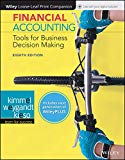
Concept explainers
(a)
Introduction:
A financial statement is the complete record of financial transactions that take place in a company at a particular period of time. It provides important financial information like assets, liabilities, revenues and expenses of the company to its internal and external users. It helps them to know the exact financial position of the company. There are four basic financial statements; they are:
- The income statement: This is a financial statement that shows the net income earned or net loss suffered by a company through reporting all the revenues earned and expenses incurred by the company over a specific period of time. An income statement is also known as an operations statement, an earnings statement, a revenue statement, or a
profit and loss statement. The net income is the excess of revenue over expenses. - The
retained earnings statement: This is a financial statement that shows the amount of net income retained by a company at a particular point of time for reinvestment and pays its debts and obligations. It shows the amount of retained earnings that is not paid as dividends to shareholders. - The balance sheet: This is a financial statement that shows the assets, liabilities, and
stockholders’ equity of a company at a particular point of time. It reveals the financial health of a company. Thus, this statement is also called as theStatement of Financial Position . It helps the users to know about the creditworthiness of a company as to whether the company has enough assets to pay off its liabilities. - Statement of
cash flows : This is a financial statement that shows the cash and cash equivalents of a company for a particular period of time. It determines the net changes in cash through reporting the sources and uses of cash due to the operating, investing, and financial activities of a company.
Annual Report: It is a comprehensive financial report that shows all the business activities that takes place throughout the previous financial year. Its purpose is to provide the complete financial information of a company’s financial activities to its users in order to help them analyze and take well informed decisions.
To determine: Company A’s total assets at September 27, 2014 and September 28, 2013.
(b)
Company A’s cash and cash equivalents on September 27, 2014.
(c)
Company A’s accounts payable on September 27, 2014 and September 28, 2013.
(d)
Company A’s net sales in 2012, 2013, and 2014.
(e)
Amount change in the net income of Company A from 2013 to 2014.
Want to see the full answer?
Check out a sample textbook solution
Chapter 1 Solutions
Financial Accounting: Tools for Business Decision Making, 8e WileyPLUS (next generation) + Loose-leaf
- I am trying to find the accurate solution to this financial accounting problem with the correct explanation.arrow_forwardPlease explain the solution to this general accounting problem with accurate explanations.arrow_forwardThe total manufacturing costs incurred for the year are $320,000. The overhead cost was 58% of the direct labor cost, and the direct material cost was $42,000. Direct labor cost was _.arrow_forward
- Stevenson has 250 kilos of metal in the beginning inventory and wants to have 180 kilos In the ending inventory.arrow_forwardFor the year ended December 31, 2020, Malek Inc. earned an ROI of 12.5%. Sales for the year were $25 million, and the average asset turnover was 4.0. Average stockholders' equity was $3.5 million. Required: a. Calculate Malek Inc.'s margin and net income. b. Calculate Malek Inc.'s return on equity.arrow_forwardWhite Co. incurs a cost of $17 per pound to produce Product X, which it sells for $25 per pound. The company can further process Product X to produce Product Y. Product Y would sell for $31 per pound and would require an additional cost of $15 per pound to be produced. The differential cost of producing Product Y is: a. $15 per pound b. $26 per pound c. $13 per pound d. $10 per pound correct answerarrow_forward
- Quick answer of this accountingarrow_forwardAsh Merchandising Company expects to purchase $88,000 of materials in July and $120,000 of materials in August. Three-quarters of all purchases are paid for in the month of purchase, and the other one-fourth are paid for in the month following the month of purchase. How much will August's cash disbursements for materials purchases be?arrow_forwardI need help with this general accounting question using standard accounting techniques.arrow_forward
 Intermediate Accounting: Reporting And AnalysisAccountingISBN:9781337788281Author:James M. Wahlen, Jefferson P. Jones, Donald PagachPublisher:Cengage Learning
Intermediate Accounting: Reporting And AnalysisAccountingISBN:9781337788281Author:James M. Wahlen, Jefferson P. Jones, Donald PagachPublisher:Cengage Learning Financial Accounting: The Impact on Decision Make...AccountingISBN:9781305654174Author:Gary A. Porter, Curtis L. NortonPublisher:Cengage Learning
Financial Accounting: The Impact on Decision Make...AccountingISBN:9781305654174Author:Gary A. Porter, Curtis L. NortonPublisher:Cengage Learning Financial AccountingAccountingISBN:9781305088436Author:Carl Warren, Jim Reeve, Jonathan DuchacPublisher:Cengage Learning
Financial AccountingAccountingISBN:9781305088436Author:Carl Warren, Jim Reeve, Jonathan DuchacPublisher:Cengage Learning Financial AccountingAccountingISBN:9781337272124Author:Carl Warren, James M. Reeve, Jonathan DuchacPublisher:Cengage LearningPrinciples of Accounting Volume 1AccountingISBN:9781947172685Author:OpenStaxPublisher:OpenStax College
Financial AccountingAccountingISBN:9781337272124Author:Carl Warren, James M. Reeve, Jonathan DuchacPublisher:Cengage LearningPrinciples of Accounting Volume 1AccountingISBN:9781947172685Author:OpenStaxPublisher:OpenStax College




